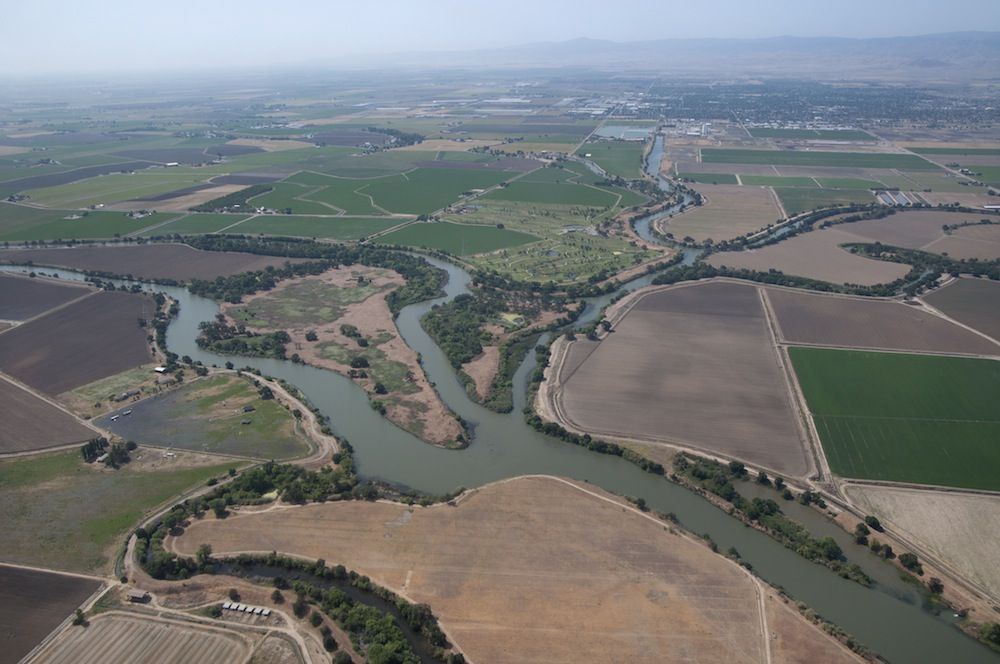America's Most Endangered River Is …

As California's San Joaquin River meanders down from the Sierra Nevada across the Central Valley toward the San Francisco Bay, it loses water to farms and communities along the way. Now, amid drought, a national river conservation agency is calling on California to manage the San Joaquin's much-needed water more efficiently.
The nonprofit American Rivers announced today (April 9) that it has deemed the San Joaquin the most endangered river in America. The organization highlights 10 rivers each year facing threats and management decisions that could make or break their futures.
"The San Joaquin has lots of problems from dams, levees and water diversions," said John Cain, the conservation director for California floodplain management at American Rivers. "It's had these problems for a long time, but this year, it's really at a tipping point." [Under Threat: See the 10 Most Endangered Rivers of 2014]
Fork in the river
There are two big legislative and management decisions facing the San Joaquin. The first is that the state's Water Resources Control Board is updating its Bay Delta Water Quality Plan. This plan governs the enormous estuary that connects the San Joaquin to the Pacific, the Bay Delta; it's the largest estuary on the west coast of either North or South America, said Eric Wesselman, executive director of the California conservation organization Friends of the River.
The estuary is a crucial habitat for fish, including the economically important Chinook salmon, Wesselman, who was not involved in the American Rivers report, told Live Science. The water board has the power to increase flows down the San Joaquin into the estuary, improving the water and habitat quality. Though there is pressure from agricultural interests to keep that water for irrigation, environmental advocates argue that increased flows are necessary to protect both the environment and the economy.
"If the estuary collapses, then these fisheries collapse," Wesselman said.
Sign up for the Live Science daily newsletter now
Get the world’s most fascinating discoveries delivered straight to your inbox.
There are also farmers near the estuary who would prefer more water get downstream, Cain added. And 23 million Californians get drinking water from the San Joaquin and south delta.
"Today, that supply is really compromised by the low quality and quantity of the San Joaquin river," Cain said.
The San Joaquin and its tributaries are extensively dammed, and water diversions remove 70 percent of the natural flow of the river, American Rivers reports. More than 100 miles (160 kilometers) of the river have run dry for half a century because of the diversions.
A second tipping point for the river involves attempts in Congress to overturn a settlement agreement to restore the San Joaquin. This settlement, hard-won over the course of two decades of litigation, is threatened by the pressures on the river's water. The problems have only worsened as California's drought drags on. In February, the Fresno Bee newspaper reported that planned water releases for the restoration have been put on hold until at least 2015.
The drought is "like putting gasoline on the fire for water politics," Wesselman said.
Water solutions
The drought, however, is not the reason American Rivers chose to highlight the San Joaquin this year, Cain said. The river's problems run deep, and would require a solution no matter how much rain California was getting, he said.
American Rivers is urging Californians to push for a sustainable management plan for the San Joaquin. Wesselman said that probably the most efficient route for reaching the Water Resources Control Board's ear is to pressure the state's governor, Jerry Brown, who appoints the board. [See Images of the San Joaquin River]
Nationally, citizens can urge their senators to oppose attempts to overturn state and federal laws that safeguard rivers from excessive diversion, Cain said.
"What we're advocating for is better water management regimes so that there is enough water for farms and fish," Cain said. "That would really require water conservation in all years and actively recharging our aquifer in wet years, so it can serve as a buffer in dry years."
About 80 percent of California's water goes to agriculture, so conservation by farmers is key, Wesselman said. Possible solutions include installing drip rather than spray irrigation; planting annual crops such as lettuce that can be tailored to wet and dry years versus plants such as nut trees that must be watered no matter the weather; and lining canals so that precious water doesn't seep into the soil instead of irrigating crops.
"The drought, in a way, is the opportunity for California to put itself on a path to a sustainable water future," Wesselman said.
American Rivers highlighted nine other endangered rivers in its report, as well. Threats range from excessive diversions to outdated dams to polluted runoff. The full list is:
1. San Joaquin River, California
2. Upper Colorado River, Colorado
3. Middle Mississippi River, Missouri, Illinois and Kentucky
4. Gila River, New Mexico
5. San Francisquito Creek, California
6. South Fork Edisto River, South Carolina
7. White River, Colorado
8. White River, Washington
9. Haw River, North Carolina
10. Clearwater and Lochsa rivers, Idaho
Follow Stephanie Pappas on Twitter and Google+. Follow us @livescience, Facebook & Google+. Original article on Live Science.

Stephanie Pappas is a contributing writer for Live Science, covering topics ranging from geoscience to archaeology to the human brain and behavior. She was previously a senior writer for Live Science but is now a freelancer based in Denver, Colorado, and regularly contributes to Scientific American and The Monitor, the monthly magazine of the American Psychological Association. Stephanie received a bachelor's degree in psychology from the University of South Carolina and a graduate certificate in science communication from the University of California, Santa Cruz.











